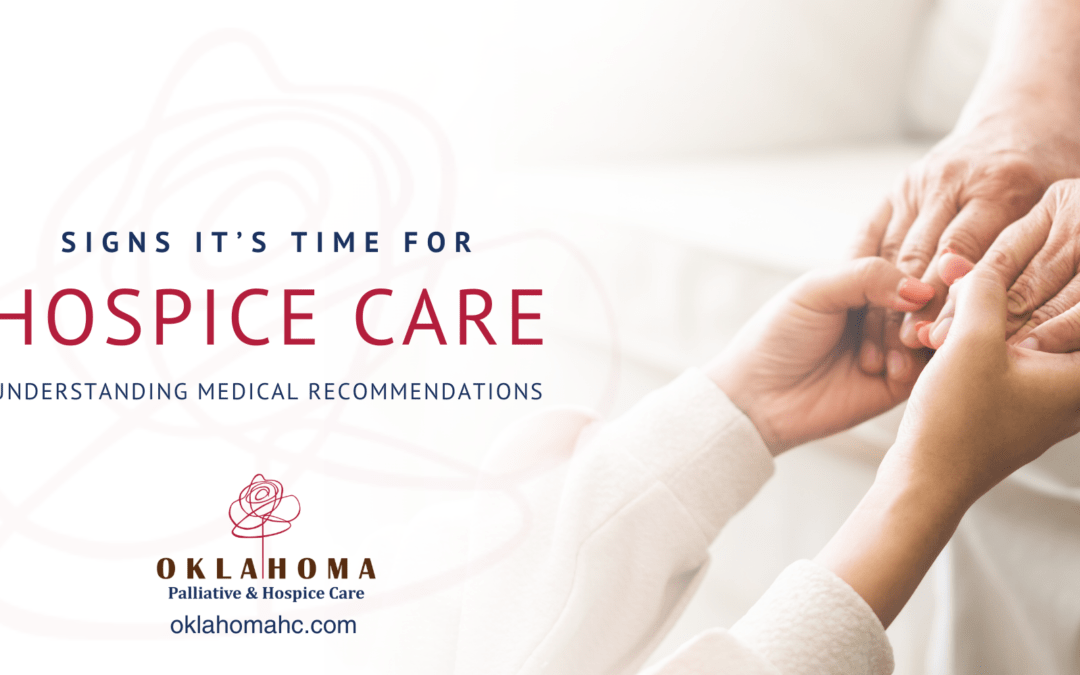When a loved one is facing a serious illness or reaching the end of their life, it can be challenging to navigate the complexities of their care. As compassionate caregivers and family members, we want to ensure their needs are met and they receive the best possible care.
Hospice offers a unique approach that focuses on enhancing the quality of life for individuals with life-limiting illnesses and supporting their families during this time. Understanding the signs that indicate it’s time for hospice care, guided by the recommendations of medical professionals, can help us make informed decisions and provide the comfort and care our loved ones need.
Typically, doctors evaluate the patient’s medical condition, disease progression, and treatment options to determine the appropriate approach. The recommendation for hospice care is often made when the illness has reached an advanced stage and further curative treatments may not be effective. Trusting the expertise and guidance of doctors helps us understand the appropriate time to seek hospice care.
Let’s delve into the signs that may indicate it’s time for hospice.
Declining Physical Health
As an illness progresses, individuals may experience a decline in physical health. Activities of daily living, such as eating, bathing, or dressing, may become increasingly difficult.
Doctors will consider the patient’s ability to perform essential functions such as eating, dressing, bathing, and walking.
Frequent Hospitalizations
Suppose your loved one is frequently hospitalized or requires multiple emergency room visits within a short period. In that case, it may be a sign that their illness is progressing and curative treatments are no longer effective.
If extensive treatments or interventions have been tried without the desired results, doctors may recommend hospice care. Failed curative treatments can take a toll on both the patient’s physical and emotional well-being, diminishing their overall quality of life. Medical professionals consider whether further treatments would lead to additional suffering or discomfort. By recognizing the limitations of curative options, doctors guide us towards hospice care, which focuses on providing comfort and support during this challenging time.
The Dartmouth Atlas of Health Care highlights that over 29% of Medicare patients who die in hospitals have spent time in the intensive care unit during their last six months of life.
Progressive Weight Loss
Unintentional weight loss is often a significant indicator of a decline in health. It can be a sign that an individual’s body is struggling to maintain its functions.
According to research published in the Journal of Palliative Medicine, weight loss greater than 10% within six months is associated with a poor prognosis.
Difficulty in Managing Symptoms
Pain, shortness of breath, nausea, and other distressing symptoms can significantly impact an individual’s quality of life. When these symptoms become increasingly difficult to manage despite medical interventions, hospice can provide specialized care to alleviate distress and provide comfort.
Physicians can evaluate whether the patient requires specialized pain management, symptom control, or psychological support that hospice care can provide. By prioritizing the patient’s comfort and well-being, doctors guide us towards hospice care when appropriate.
The United States Agency for Healthcare Research and Quality (AHRQ) states that hospice patients consistently report better pain management than those receiving other forms of care.
Increasing Need for Assistance
As an illness progresses, individuals may require more assistance with basic activities, including walking, communication, and medication management. When their need for support significantly increases, it may indicate that hospice care can provide an enhanced level of care to meet their needs.
Hospice care can provide specialized support tailored to their needs. Doctors understand the importance of maintaining dignity and autonomy, and their recommendations guide us towards the appropriate level of care.
The NHPCO reports that approximately 40% of hospice patients receive care in their place of residence, allowing patients and their families to remain comfortably in their own homes.
Recognizing the signs that it might be time for hospice care can bring relief and support to both individuals facing a life-limiting illness and their families. Remember, hospice is not about giving up hope but instead shifting the focus towards enhancing the quality of life and providing comfort during a challenging time.
The recommendations from doctors are based on a comprehensive evaluation of the patient’s prognosis, life expectancy, palliative care needs, failed curative treatments, and declining functional status. By trusting their recommendations, we can provide our loved ones with the comfort, compassion, and enhanced quality of life they deserve during this difficult time.
If you find yourself facing this decision, remember that you are not alone. Reach out to healthcare professionals, engage in open and honest conversations, and explore the hospice care options available to you. Hospice care is designed to bring solace and support to patients and their families, offering a compassionate environment that embraces the precious moments shared during the end-of-life journey.
Need help? Contact us at (405) 418-2659.

